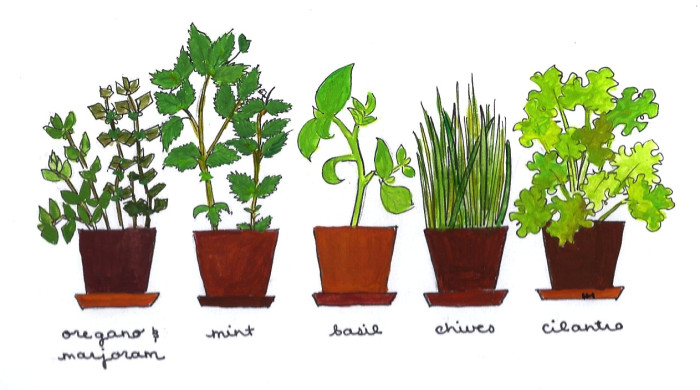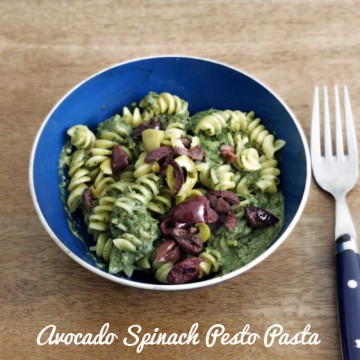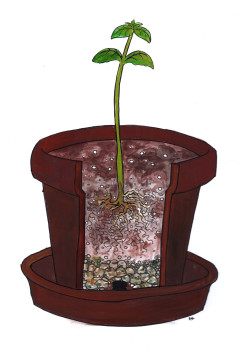Having an array of beautiful herbs in your kitchen or window sill can be one of the best ways to spice up your healthy eating routine. You don’t have to be an experienced green thumb! Here’s how to get started with your kitchen garden.
Step 1. Choose Your Plants
If this is your first foray into gardening, start small. Once you keep one or two plants alive, you’ll be ready to add to the garden! Choose herbs that you like to cook with, ensuring they’ll be trimmed frequently and you’ll be a happy cook. Herb plants with smaller foliage do better indoors, so if you’ve got a black thumb, opt for plants with small leaves like oregano.
There are two options for starting a home garden: starting from seed or buying herbs that have already been started at a garden center or farm. Seeding plants can be difficult, but some plants are easier to keep up than others. Some easy plants to seed indoors are basil, chives, cilantro, mint, oregano and marjoram.
Basil (Ocimum basilicum)
Basil grows as an annual or short-lived perennial with a lovely aroma. When flowering tops appear, cut them off to encourage new leaves and keep them from going bitter. (The blooms are edible, as are most herb flowers.) There are a couple varieties of basil commonly available: Try “Genovese” for the most classic aroma and flavor; “Spicy Globe” for more compact growth, closer to 8 to 10 inches tall; or “Siam Queen” for which has a distinct spicy flavor, for your Thai dishes!
Cooking tip: Basil is best fresh. Always toss it in at the end of cooking—heat damages its flavor and color.
Recipe: Creamy Avocado Spinach Pesto Pasta
Chives (Allium schoenoprasum)
Chives are mild onion flavored grass-like sprouts, which have edible flowers in spring and early summer. Chives can be grown from seed, or purchased at garden centers and farmers markets all summer into fall. Like most herbs, trimming regularly encourages production. Chives can be cut down more than other herbs, and are very hard to kill. Some tasty varieties include “Compact Grolau” which is great for containers and windowsills, and “Grande” features big, broad leaves instead of narrow, grass-like leaves.
Cooking tip: You can freeze excess chives; use them as you would fresh. The edible flowers can also be frozen!
Recipe: Chive Flower Tempura
Cilantro (Coriandrum sativum)
Cilantro grows fast, and is easy to grow from seed. It’s also known as Chinese parsley, and has a distinctive parsley/sage/citrus-like flavor. The entire cilantro plant is edible: enjoy the flowers, the leaves, the brown seeds (coriander) and the roots (in soups and stir-fries). Plant a few seeds each month to keep it in your garden year round. Some excellent varieties for window gardens are “Santo,” which lasts quite long; “Delfino” has fancy, lacy leaves that look lovely on the sill.
Tip: The ripe seeds are the orange-scented spice known as coriander. To harvest coriander, allow plants to flower and then collect seeds after they turn brown.
Recipe: Cilantro- Jalapeño Hummus
Mint [Peppermint (M. x piperita) and spearmint (M. spicata)]
Mint can be started from seed, but plants bought at farmers’ markets and garden centers often have better flavor. Mint is notoriously aggressive, so it’s best to grow it in smaller, separate containers from other herbs. Clipping growing tips monthly encourages new growth, and are great for tea. Peppermints and spearmints are best for cooking but have distinct flavor profiles; another variety, “Pineapple Mint,” has beautiful variegated leaves.
Tip: Mint is versatile and easy to dry. Cut the stems an inch or two off the soil. Wash and dry it, bundle the stems and hang it up in a cool, dry place.
Recipe: Cucumber Mint Lemonade
Oregano (Origanum vulgare ssp. Hirtum) and Marjoram (Origanum spp.)
The varieties of oregano and marjoram vary in size, flavor and growth habits. All are easy to grow from seeds. Hardy oregano can survive in an unheated garage, even in colder climates, and is a great plant for beginners. Like most herbs, the flowers can be trimmed to promote leaf growth and are edible. “Kaliteri” or “Greek” oregano has the best flavor for a pure oregano. “Italian oregano” is a delicious marjoram-oregano cross that has a spicy profile. “Sweet marjoram” is distinctively sweeter and more delicate.
Tip: Oregano has the strongest flavor in the summer, which is when it is best to dry.
Recipe: Vegan Ratatouille Pizza
Next -> Step 2
Step 2. Find Them A Home
Choose a sunny location. Try to position your pots directly beneath a sunny, east- or south-facing window, or directly beneath skylights, to maximize the sunlight. Six hours a day of sunlight is ideal; however, mint, parsley and chives do fine with four to five. If you are committed to indoor gardening but have low light, consider a “grow light.” If you live in a northern climate, keep in mind the sunlight reduces significantly in the winter, and plants may benefit from an extra source of light.
Ideally, place the plants in or near the kitchen to ensure regular care and use. Best location has a temperature between 55 and 75 degrees F, with good air circulation.
Almost any pot or container at least 6 inches or larger can be used for growing herbs as long as it has drainage holes. Choose the largest pot possible to provide more room for growing roots, which will give you a bigger plant to harvest from. Use a container with good drainage, with a saucer underneath to keep the pot from leaking. If you only have a sealed pot, place rocks at the base and toss some vermiculite into the soil to aid with drainage, otherwise the roots will rot!
When planting in indoor pots, use a fast-draining potting mix. Look for a mix that includes ingredients such as perlite or vermiculite which will keep the soil from compacting. Most importantly, no matter how much you love your new household additions, avoid over-fertilizing and over-watering. The scent and flavor of herbs can concentrate in a lovely way when they are given time to dry out between watering and plenty of time between feedings. Water herbs every few days, depending on climate and the individual plants. Fertilize once a month at most.
Step 3. Take Care
Once your herbs start sprouting, they need to be fertilized with liquid fertilizer or gently raked with compost monthly to keep them bright and perky.
Make sure your herbs get an inch of water each week, letting the top inch or two of the pot dry out before watering again. Most herbs like to be watered well, but will rot if not given a chance to dry out. That’s why good drainage is so important. Use a spritzer or a small, gentle watering can to prevent displacing the potting soil.
If you tend to over-water, try keeping a calendar. Most plants die because of too much love, though being forgotten about isn’t great either. As plants grow, pots can be moved around, as the seasons and light conditions change. Remember to rotate your pots, so that your herbs don’t become too “leggy.” (All stem, no leaves or blooms.)
Make sure you crack a window or have a fan in your herb garden’s new home. Herbs grown in stuffy, over-warm rooms attract pests, and also grow weak and spindly. Air circulation is necessary for the plant to breathe, even in the winter months.
Trimming the herbs is also a necessary part of keeping them productive and healthy, so don’t be afraid to trim them and use them.
Step 4. Enjoy!
Add labels to each of your freshly planted herbs to make them easy to identify when cooking. Some herbs, like parsley and cilantro, look very similar even when full grown.
Wait until the herbs are mature before you trim, but take only a little bit each time you harvest. If you remove more than a third of the plant at one time, it takes longer to recover and produce new foliage. Wait for the plant to grow back before trimming again.
With responsible picking, most herbs can be harvested for several months. Pinch and use often. Even young plants need to be trimmed in order to encourage fullness. Flowers that appear should be trimmed immediately, to ensure the most vibrant flavor and fullness.
Tip: Fresh herbs taste best when harvested in the morning, and most flavorful if harvested before they bloom. Most annual herbs taste their best before they flower. Once the annual herbs flower, they older leaves begin to decline and new leaves can be smaller and bitter.
Do you guys have a kitchen garden? What’s your favorite herb?
Also in Home: 10 Ways to Become More Eco Friendly
__
Photo: Peaceful Dumpling
Illustrations: Haley Houseman







